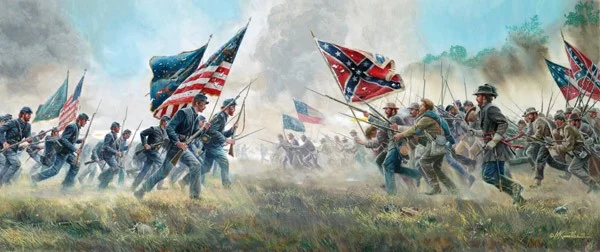Who were the Signers of the Declaration of Independence?
The signers of the Declaration of Independence were a collection of men, different in skills and background, that came together to support and sign a declaration of independence from Great Britain, right?
Actually, that glorified view of the signers has been created through art, media, and storytelling, like 1776. However, the actual scene beheld by one of the time would have told you a different story.
First, let us categorize the thirteen colonies, North and South. The dialects, laws, and morals of the two groups clash with the other, making it near impossible for all thirteen states to agree on a whole set of issues. Also, during the entire American Revolution, only around 40%-45% of the colonists actively supported the patriot cause. In other words, some colonial governments did not even want independence to occur. This meant that their chosen representatives in the Second Continental Congress could not vote for independence without their permission.
However, the Declaration was signed, created, and judged for its beauties and flaws. It was created by imperfect men for imperfect purposes, the foremost purpose being the need for unanimity in the voting for independence from Britain.
These are the signers of the Declaration of Independence:
John Adams (MA)
Samuel Adams (MA)
Josiah Barlett (NH)
Carter Braxton (VA)
Charles Carroll of Carrollton (MD)
Samuel Chase (MD)
Abraham Clark (NJ)
George Clymer (PA)
William Ellery (RI)
William Floyd (NJ)
Benjamin Franklin (PA)
Elbridge Gerry (MA)
Button Gwinnett (GA)
Lyman Hall (GA)
John Hancock (MA)
Benjamin Harrison (VA)
John Hart (NJ)
Joseph Hewes (NC)
Thomas Heyward Jr. (SC)
William Hooper (NC)
Stephen Hopkins (RI)
Francis Hopkinson (NJ)
Samuel Huntington (CT)
Thomas Jefferson (VA)
Francis Lightfoot Lee (VA)
Richard Henry Lee (VA)
Francis Lewis (NY)
Philip Livingston (NY)
Thomas Lynch Jr. (SC)
Thomas McKean (DE)
Arthur Middleton (SC)
Lewis Morris (NY)
Robert Morris (PA)
John Morton (PA)
Thomas Nelson Jr. (VA)
William Paca (MD)
Robert Treat Paine (MA)
John Penn (NC)
George Read (DE)
Caesar Rodney (DE)
George Ross (PA)
Dr. Benjamin Rush (PA)
Edward Rutledge (SC)
Roger Sherman (CT)
James Smith (PA)
Richard Stockton (NJ)
Thomas Stone (MD)
George Taylor (PA)
Matthew Thornton (NH)
George Walton (GA)
William Whipple (NH)
William Williams (CT)
James Wilson (PA)
John Witherspoon (NJ)
Oliver Wolcott (CT)
George Wythe (VA)
Behind these names are some of the most inspiring stories in American history. We have George Wythe, the mentor; James Wilson, the Scotsman; Button Gwinnett, a martyr for his ego; and Benjamin Franklin, the ancient lion of liberty.
However, there were members of the Second Continental Congress that did not sign the Declaration of Independence, and they must also be remembered for their actions in the battle for independence. For example, John Dickinson, a member of the Pennsylvanian delegation, was a tremendously great orator and writer in the cause of freedom, with exception of his leadership of those against the Declaration of Independence in 1776. The item to remember to those in opposition to the Declaration of Independence was not the idealism of independence, but the time that independence should be declared.
Now, let us start with John Adams; let us go through the list and explain the lives of each of the signers of the Declaration of Independence.






